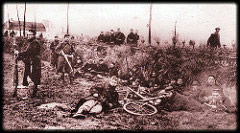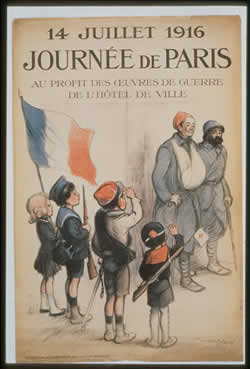Languages Stage 5
Overview

Anonyme 14 — 2ème bataille d'Ypres, Belgique 1915, Eclaireurs Belges au repos (Belgian Scouts resting)
Students read letters from home and the war front written in their target language during the First World War. They research everyday life during the period. Assuming the role of family member of a soldier on the front, students write a letter either about their daily life or the challenges the soldier faces.
Teaching and learning activities

Journée de Paris, 14 Juillet 1916. Au profit des oeuvres de guerre de l’Hôtel de Ville
©Public domain (Library of Congress LC-USZC2-3963 )
What did people communicate about their lives and challenges between the home front and the war front during the First World War?
-
Provide students with a stimulus text, for example, a letter from the First World War in the target language.
-
As a class read the stimulus text and identify the purpose. Who is writing the letter? Where are they? Who are they writing to?
-
Make a list of similarities and differences between the war and at home. What is different with life on the front and life at home?
-
Students research information that describes everyday life during the war that could be used in a letter.
-
Encourage students to think about what they ate, wore and did for recreation.
-
Students make a list of the structures they could use to respond to the letter. Follow all the features of a letter: date, greeting, introduction, body and closing.
-
Teacher models letter writing features.
-
Assuming the role of a family member of a soldier on the front, students write a letter either about their daily life or the challenges the soldier faces.
-
Include cultural elements that would have been relevant during the period in the First World War.
Resources:
Information about the war, the regions involved, itineraries: Itinerari della grande guerra
Untold stories and official histories of the First World War: Europeana 1914–1918 – untold stories & official histories of WW1
Biographies of Italians in the war: Touched by war: The four Rocconi brothers
Online resources to generate discussion Commémoration du centenaire de la Première Guerre mondiale
Resources that explore the First World War and cause and effect Explorer la grande guerre : Ressources en lignes
Letters from the front: Google image search: lettres soldats grande guerre
Learning concepts
These additional questions can be used for discussion or further investigations.
Challenge
What challenges were faced in communicating from the war front to home?
Caring
What did soldiers communicate and not communicate to their loved ones back home? Why?
What did people at home communicate and not communicate to their loved ones at the war front? Why?
Community
How did Australia support its allied countries from the home front, for example, French and Belgian orphans?
Syllabus links
Reading and responding
5.UL.2 A student selects, summarises and analyses information and ideas in written texts and responds appropriately.
Students learn about:
-
ways in which texts are formatted for particular purposes and effects
-
ways in which texts are constructed for specific purposes
-
ways of identifying relevant details when reading for specific information
-
the use of multimedia for communicative purposes
5.UL.4 A student experiments with linguistic patterns and structures in (language) to convey information and to express own ideas.
Students learn about:
-
the manipulation of structure, format and choice of vocabulary to achieve specific purposes
-
application of known linguistic structures in new contexts
-
resources available to enhance or promote independent learning
-
the use of technology to express ideas and create own text
Making linguistic connections
5.MLC.2 A student uses linguistic resources to support the study and production of texts in (language).
Students learn about:
-
the importance of being aware of the choices that are made to convey precise meaning
-
the effect of linguistic choices on intended meaning
-
meaning conveyed in words
Moving between cultures
5.MBC.2 A student identifies and explains aspects of the culture of (language)-speaking communities in texts.
Students learn about:
-
cultural attitudes that add meaning to texts
-
language used to express cultural values, and to represent people and cultures in texts
-
idioms, colloquialisms, register and formality in language use